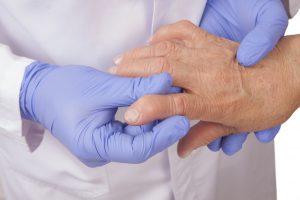What is rheumatoid arthritis (RA)?
In the UK, rheumatoid arthritis affects more than 400,000. Furthermore an estimated that in the US 1.5 million adults have rheumatoid arthritis. This condition is characterized by severe inflammation of the joints. Rheumatoid arthritis is an autoimmune disease, in which the immune system acts against the healthy cells of the body. In addition, inflammation occurs without the presence of a harmful virus or a bacterium (a so-called ‘sterile’ inflammation). In the case of rheumatoid arthritis, the immune cells attack the mucous membranes (synovia) that coat the inside of the joints. This causes chronic inflammation, which may eventually damage the cartilage, joints, tendons and muscles. The cause of rheumatoid arthritis is still unknown.
Also read the article on ‘What is Rheumatism?’

Rheumatoid arthritis starts with an inflammation of the mucosa. Gradually, there are more changes in the joint that cannot be reversed. Fighting the inflammation at an early stage is therefore important!
What are the symptoms of rheumatoid arthritis?
The symptoms are pain, swelling and (morning) stiffness in the joints. Thickening of the joint mucous membranes causes these symptoms. This thickening is due to an extreme increase in the number of cells due to inflammation. The inflammation causes the cells in the mucous membrane to multiply unusually fast (hyperplasia). Due to the thickening of the mucous membranes, they become less permeable to fluid from the blood vessels. This can result in an abnormal amount of joint fluid (read more under “What is joint fluid?”) and disturbed hydrostatic pressure in the joint. These symptoms may also cause new inflammation and increase the pain. Over time, “rheumatic bumps” can also occur. These are mainly on the hands and elbows.

A typical image of rheumatic hands
What are the effects of rheumatoid arthritis?
This is a progressive disease. That means that the symptoms worsen over time. Leaving rheumatoid arthritis untreated may result in permanent damage to joints . In 75 percent of patients, joint damage has been reported after a few years, which was visible on X-rays. Therefore, it is important to recognize the symptoms of rheumatoid arthritis in a timely fashion in order to start treatment as soon as possible.
How do you treat rheumatoid arthritis?
To treat rheumatoid arthritis you must treat inflammation of the joints, by suppressing the immune system. The goal is to treat the inflammation, while still allowing the body to keep fighting off infection. Your physician will, in many cases, prescribe anti-inflammatory analgesics. These are NSAIDs (Non-Steroidal Anti-Inflammatory Drugs). Corticosteroids are powerful anti-inflammatory inhibitors which are given in severe situations. DMARDs (Disease Modifying Anti-Rheumatic Drugs) are slow-acting anti-inflammatory inhibitors.
For about ten years now, TNF-α blockers are also available. Tumor necrosis Factor-alpha (TNF-α) is a protein which is produced by immune cells when inflammation occurs. TNF-α proteins are also called inflammatory factors. Joint fluid of patients with rheumatoid arthritis contains too high levels of TNF-α. This inflammatory factor can be eliminated by certain substances in TNF-α blockers, thus stopping arthritis inflammation. A natural alternative to a TNF-α blocker is Curcumin: Curcumin has a strong anti-inflammatory action because it can effectively inhibit TNF-α.

Share this page
Tweet

Download for free the booklet ‘Moving without pain’ with a retail value of $6.75 / £4.95.
Any questions? Please feel free to contact us. Contact us





